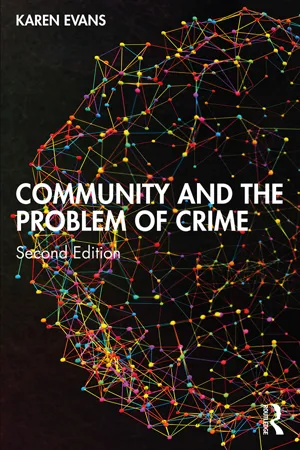
- 224 pages
- English
- ePUB (mobile friendly)
- Available on iOS & Android
Community and the Problem of Crime
About this book
This book offers a useful theoretical overview of key approaches to the subject of crime and community and considers the ways in which these have been applied in more practical settings. Written by an expert in the field and drawing on a range of international case studies from Europe, North America, Australia and Asia, this book explores both why and how crime and community have been linked and the implications of their relationship within criminology and crime prevention policy.
Topics covered in the book include:
- the different crime prevention paradigms which have been utilized in the 'fight against crime'
- the turn to community in crime prevention policy, which took place during the 1980s in the UK and US, and its subsequent development
- the theoretical and ideological underpinnings to crime prevention work in and with different communities
- the significance and impact of fear of crime on crime prevention policy
- different institutional responses to working with community in crime prevention and community safety
- the ways in which the experiences of the UK and US have been translated into the European context
- a comparison between traditional western responses to the growing interest in restorative and community-based approaches in other regions.
The new edition has been fully revised and updated to include discussion of the rise of populist politics and the centrality of 'crime' and 'disorder' as a divisive element used in populist political rhetoric; the politics of austerity and the management of crises – economic, environmental and COVID-19 and the subsequent lockdowns; the impact of Black Lives Matter, MeToo and Extinction Rebellion; the significance of social media and virtual community; the further erosion of civil liberties and the right to protest; and racialized US policing practices and police-related deaths. This book offers essential reading for students taking courses on crime and community, crime prevention and community safety and community corrections.
Frequently asked questions
- Essential is ideal for learners and professionals who enjoy exploring a wide range of subjects. Access the Essential Library with 800,000+ trusted titles and best-sellers across business, personal growth, and the humanities. Includes unlimited reading time and Standard Read Aloud voice.
- Complete: Perfect for advanced learners and researchers needing full, unrestricted access. Unlock 1.4M+ books across hundreds of subjects, including academic and specialized titles. The Complete Plan also includes advanced features like Premium Read Aloud and Research Assistant.
Please note we cannot support devices running on iOS 13 and Android 7 or earlier. Learn more about using the app.
Information
Table of contents
- Cover
- Half Title
- Title Page
- Copyright Page
- Dedication
- Table of Contents
- List of boxes
- Introduction
- 1. The meaning and uses of community
- 2. Community and crime
- 3. Disorderly communities
- 4. Regenerating communities
- 5. Fractured communities
- 6. Suspect and profiled communities
- 7. Policing communities
- 8. The problem of community
- Index